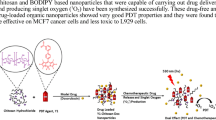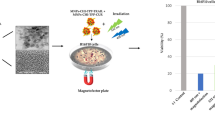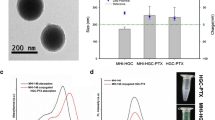Abstract
Nanoparticles (NPs) are one of the most preferred materials in drug release systems. Photodynamic therapy (PDT) acts by activating natural components with light to form radicals and causing death due to intracellular toxicity. Hypericin (HY) which was derived from Hypericum perforatum was used as a photosensitizer and anticancer agent. It is already known that cytotoxicity, antiproliferative and antitumor effects of HY-mediated PDT. However, HY is clustered in an aqueous environment which decreases its efficiency. Therefore, it was preferred to be used with NP-based carriers. In this study, HY-loaded chitosan NPs (HY-CH-NPs) were prepared for in vitro assessment. It was aimed to increase the cytotoxic effect of HY by prolonging the duration and uptake of HY action in the A549 lung cancer cells after PDT irradiation (6 J/cm2) with fluorescent lamps. HY-CH-NPs were characterized to examine their size and surface change with dynamic light scattering (DLS) and scanning electron microscopy (SEM), and it was achieved that the particles were below 400 nm diameter. All HY-CH-NPs showed a peak at around 1260 cm−1 according to FTIR spectrum. With the FITC staining, the penetration of NPs into the cell was demonstrated. And the drug (HY) loading efficiency was found as 3%. The cell viability decreased to 56% in the HY-CH-NP group after 48 h incubation in MTT assay. The amount of ROS in the HY-CH-NP 600 nM group was formed 1.6 times higher in the DCFDA analysis, and the total cell death was 40% in the AO/PI staining. It was observed that nanoparticles were able to cross the cell membrane barrier, and as a result of it, apoptosis and secondary necrosis were induced in the cancer cell. Lactate dehydrogenase release was also the highest in the 600 nM HY-CH-NP group, indicating increased necrotic cell death.
Graphical Abstract










Similar content being viewed by others
References
Ferlay, J., Colombet, M., Soerjomataram, I., Mathers, C., Parkin, D. M., Piñeros, M., Znaor, A., & Bray, F. (2019). Estimating the global cancer incidence and mortality in 2018: GLOBOCAN sources and methods. International Journal of Cancer, 144(8), 1941–1953. https://doi.org/10.1002/ijc.319372
World Health Organisation. (2021). World Source:Globocan, 2020 https://gco.iarc.fr/today/data/factsheets/cancers/15-Lung-fact-sheet.pdf .
Li, X., Lovell, J. F., Yoon, J., & Chen, X. (2020). Clinical development and potential of photothermal and photodynamic therapies for cancer. Nature Reviews Clinical Oncology, 17(11), 657–674. https://doi.org/10.1038/s41571-020-0410-2
Kubin, A., Wierrani, F., Burner, U., Alth, G., & Grunberger, W. (2005). Hypericin-the facts about a controversial agent. Current Pharmaceutical Design, 11(2), 233–253. https://doi.org/10.2174/1381612053382287
Kleemann, B., Loos, B., Scriba, T. J., Lang, D., & Davids, L. M. (2014). St John’s wort (Hypericum perforatum L.) photomedicine: hypericin-photodynamic therapy induces metastatic melanoma cell death. PLoS ONE, 9(7), e103762. https://doi.org/10.1371/journal.pone.0103762
Kılıç Süloğlu, A., Selmanoğlu, G., & Akay, M. T. (2015). Alterations in dysadherin expression and F-actin reorganization: a possible mechanism of hypericin-mediated photodynamic therapy in colon adenocarcinoma cells. Cytotechnology, 67(2), 311–330. https://doi.org/10.1007/s10616-013-9688-6
Popescu, R., Ghica, M. V., Dinu-Pîrvu, C. E., Anuța, V., Lupuliasa, D., & Popa, L. (2020). New opportunity to formulate intranasal vaccines and drug delivery systems based on chitosan. International Journal of Molecular Sciences, 21(14), 5016.
Huang, W. T., Larsson, M., Lee, Y. C., Liu, D. M., & Chiou, G. Y. (2016). Dual drug-loaded biofunctionalized amphiphilic chitosan nanoparticles: enhanced gesynergy between cisplatin and demethoxycurcumin against multidrug-resistant stem-like lung cancer cells. European Journal of Pharmaceutics and Biopharmaceutics, 109, 165–173. https://doi.org/10.1016/j.ejpb.2016.10.014
Nalini, T., Basha, S. K., Mohamed Sadiq, A. M., Kumari, V. S., & Kaviyarasu, K. (2019). Development and characterization of alginate/chitosan nanoparticulate system for hydrophobic drug encapsulation. Journal of Drug Delivery Science and Technology, 52, 65–72. https://doi.org/10.1016/j.jddst.2019.04.002
Kavaz, D., Odabaş, S., Güven, E., Demirbilek, M., & Denkbaş, E. B. (2010). Bleomycin loaded magnetic chitosan nanoparticles as multifunctional nanocarriers. Journal of Bioactive and Compatible Polymers, 25(3), 305–318. https://doi.org/10.1177/0883911509360735
Tamahkar, E., Bakhshpour, M., & Denizli, A. (2019). Molecularly imprinted composite bacterial cellulose nanofibers for antibiotic release. Journal of Biomaterials Science, Polymer Edition, 30(6), 450–461. https://doi.org/10.1080/09205063.2019.1580665
Ge, Y., Zhang, Y., He, S., Nie, F., Teng, G., & Gu, N. (2009). Fluorescence modified chitosan-coated magnetic nanoparticles for high-efficient cellular imaging. Nanoscale Research Letters, 4(4), 287. https://doi.org/10.1007/s11671-008-9239-9
Kılıç Süloğlu, A., Karacaoğlu, E., Selmanoğlu, G., Akel, H., & Karaaslan, İ. Ç. (2016). Evaluation of apoptotic cell death mechanisms induced by hypericin-mediated photodynamic therapy in colon cancer cells. Turkish Journal of Biology, 40(3), 539–546. https://doi.org/10.3906/biy-1504-6
Aldemir, E. E. (2020). Beta hücreleri̇ neoeri̇osi̇tri̇ni̇n investigation of protective effect of neoeriocitrin in Ins-1E pancreatic beta cells in diabetic model. Dissertation,. Hacettepe University.
Thandapani, G., Supriya Prasad, P., Sudha, P. N., & Sukumaran, A. (2017). Size optimization and in vitro biocompatibility studies of chitosan nanoparticles. International Journal of Biological Macromolecules, 104, 1794–1806. https://doi.org/10.1016/j.ijbiomac.2017.08.057
Ulu, A., Sezer, S. K., Yüksel, Ş., Koç, A., & Ateş, B. (2021). Preparation, controlled drug release, and cell viability evaluation of tenofovir alafenamide-loaded chitosan nanoparticles. Starch-Stärke, 2100144. https://doi.org/10.1002/star.202100144
Gao, C., Jian, J., Lin, Z., Yu, Y. X., Jiang, B. P., Chen, H., & Shen, X. C. (2019). Hypericin-loaded carbon nanohorn hybrid for combined photodynamic and photothermal therapy in vivo. Langmuir, 35(25), 8228–8237. https://doi.org/10.1021/acs.langmuir.9b00624
Ali, S. W., Rajendran, S., & Joshi, M. (2011). Synthesis and characterization of chitosan and silver loaded chitosan nanoparticles for bioactive polyester. Carbohydrate Polymers, 83(2), 438–446. https://doi.org/10.1016/j.carbpol.2010.08.004
Sarmento, B., Ferreira, D., Veiga, F., & Ribeiro, A. (2006). Characterization of insulin-loaded alginate nanoparticles produced by ionotropic pre-gelation through DSC and FTIR studies. Carbohydrate Polymers, 66(1), 1–7.
Agnihotri, S. A., & Aminabhavi, T. M. (2007). Chitosan nanoparticles for prolonged delivery of timolol maleate. Drug Development and Industrial Pharmacy, 33(11), 1254–1262. https://doi.org/10.1080/03639040701384942
Nair, R. S., Morris, A., & Billa, N. (2019). An evaluation of curcumin-encapsulated chitosan nanoparticles for transdermal delivery. AAPS PharmSciTech, 20, 69. https://doi.org/10.1208/s12249-018-1279-6
Fathalla, Z. M. A., Khaled, K. A., Hussein, A. K., Alany, R. G., & Vangala, A. (2016). Formulation and corneal permeation of ketorolac tromethamine-loaded chitosan nanoparticles. Drug Development and Industrial Pharmacy, 42(4), 514–524. https://doi.org/10.3109/03639045.2015.1081236
Abu Dayyih, A., Alawak, M., Ayoub, A. M., Amin, M. U., Abu Dayyih, W., Engelhardt, K., Duse, L., Preis, E., Brüßler, J., & Bakowsky, U. (2021). Thermosensitive liposomes encapsulating hypericin: characterization and photodynamic efficiency. International Journal of Pharmaceutics, 609, 121–195. https://doi.org/10.1016/j.ijpharm.2021.121195
Huntošová, V., Datta, S., Lenkavská, L., Máčajová, M., Bilčík, B., Kundeková, B., Čavarga, I., Kronek, J., Jutková, A., Miškovský, P., & Jancura, D. (2021). Alkyl chain length in poly(2-oxazoline)-based amphiphilic gradient copolymers regulates the delivery of hydrophobic molecules: a case of the biodistribution and the photodynamic activity of the photosensitizer hypericin. Biomacromolecules, 22(10), 4199–4216. https://doi.org/10.1021/acs.biomac.1c00768
Boruah, S., & Dutta, P. (2021). Fungus-mediated biogenic synthesis and characterization of chitosan nanoparticles and its combine effect with Trichoderma asperellum against Fusarium oxysporum, Sclerotium rolfsii and Rhizoctonia solani. Indian Phytopathology, 74(1), 81–93. https://doi.org/10.1007/s42360-020-00289-w
Zavareh, H. S., Pourmadadi, M., Moradi, A., Yazdian, F., & Omidi, M. (2020). Chitosan/carbon quantum dot/aptamer complex as a potential anticancer drug delivery system towards the release of 5-fluorouracil. International Journal of Biological Macromolecules, 165, 1422–1430.
Teong, B., Lin, C. Y., Chang, S. J., Niu, G. C., Yao, C. H., Chen, I. F., & Kuo, S. M. (2015). Enhanced anti-cancer activity by curcumin-loaded hydrogel nanoparticle-derived aggregates on A549 lung adenocarcinoma cells. Journal of Materials Science: Materials in Medicine, 26, 49.
Huang, M., Ma, Z., Khor, E., & Lim, L. Y. (2002). Uptake of FITC-chitosan nanoparticles by A549 cells. Pharmaceutical Research, 19(10), 1488–1494. https://doi.org/10.1023/a:1020404615898
Duse, L., Baghdan, E., Pinnapireddy, S. R., Engelhardt, K. H., Jedelská, J., Schaefer, J., Quendt, P., & Bakowsky, U. (2018). Preparation and characterization of curcumin loaded chitosan nanoparticles for photodynamic therapy. Physica Status Solidi (A) Applications and Materials. Science, 215(15), 1–5. https://doi.org/10.1002/pssa.201700709
Penjweini, R., Loew, H. G., Breit, P., & Kratky, K. W. (2013). Optimizing the antitumor selectivity of PVP-Hypericin re A549 cancer cells and HLF normal cells through pulsed blue light. Photodiagnosis and Photodynamic Therapy, 10(4), 591–599. https://doi.org/10.1016/j.pdpdt.2013.06.005
Mokoena, D., George, B. P., & Abrahamse, H. (2022). Conjugation of hypericin to gold nanoparticles for enhancement of photodynamic therapy in MCF-7 breast cancer cells. Pharmaceutics, 14, 2212.
Hu, J., Song, J., Tang, Z., Wei, S., Chen, L., & Zhou, R. (2021). Hypericin-mediated photodynamic therapy inhibits growth of colorectal cancer cells via inducing S phase cell cycle arrest and apoptosis. European Journal of Pharmacology, 900, 174071. https://doi.org/10.1016/j.ejphar.2021.174071
Li, W. T. (2013). Nanoparticles for photodynamic therapy. Wiley-VCH Verlag GmbH & Co. KGaA. https://doi.org/10.1002/9783527643981.bphot030
Guo, X., Zhuang, Q., Ji, T., Zhang, Y., Li, C., Wang, Y., Li, H., Jia, H., Liu, Y., & Du, L. (2018). Multi-functionalized chitosan nanoparticles for enhanced chemotherapy in lung cancer. Carbohydrate Polymers, 195, 311–320.
Damke, G. M. Z. F., Damke, E., de Souza, B.-M. P., Ratti, B. A., de Freitas Meirelles, L. E., da Silva, V. R. S., Gonçalves, R. S., César, G. B., de Oliveira, S. S., Caetano, W., Hioka, N., Souza, R. P., & Consolaro, M. E. L. (2020). Selective photodynamic effects on cervical cancer cells provided by P123 Pluronic®-based nanoparticles modulating hypericin delivery. Life Sciences, 255, 117858. https://doi.org/10.1016/j.lfs.2020.117858
Mikeš, J., Hýžďalová, M., Kočí, L., Jendželovský, R., Kovaľ, J., Vaculová, A., Hofmanová, J., Kozubík, A., & Fedoročko, P. (2011). Lower sensitivity of FHC fetal colon epithelial cells to photodynamic therapy compared to HT-29 colon adenocarcinoma cells despite higher intracellular accumulation of hypericin. Photochemical & Photobiological Sciences, 10(4), 626. https://doi.org/10.1039/c0pp00359j
Sharma, K. V., & Davids, L. M. (2012). Hypericin-PDT-induced rapid necrotic death in human squamous cell carcinoma cultures after multiple treatment. Cell Biology International, 36(12), 1261–1266. https://doi.org/10.1042/CBI20120108
Shui, S., Zhao, Z., Wang, H., Conrad, M., & Liu, G. (2021). Non-enzymatic lipid peroxidation initiated by photodynamic therapy drives a distinct ferroptosis-like cell death pathway. Redox Biology, 45. https://doi.org/10.1016/j.redox.2021.102056
Huntosova, V., Nadova, Z., Dzurova, L., Jakusova, V., Sureau, F., & Miskovsky, P. (2012). Cell death response of U87 glioma cells on hypericin photoactivation is mediated by dynamics of hypericin subcellular distribution and its aggregation in cellular organelles. Photochemical & Photobiological Sciences, 11(9), 1428. https://doi.org/10.1039/c2pp05409d
Du, H., Olivo, M., Tan, B. K.-H., & Bay, B.-H. (2003). Hypericin-mediated photodynamic therapy induces lipid peroxidation and necrosis in nasopharyngeal cancer. International Journal of Oncology, 23(5), 1401–1405.
Han, X., Taratula, O., Xu, K., St Lorenz, A., Moses, A., Jahangiri, Y., Yu, G., & Farsad, K. (2020). Biodegradable hypericin-containing nanoparticles for necrosis targeting and fluorescence imaging. Molecular Pharmaceutics, 17(5), 1538–1545. https://doi.org/10.1021/acs.molpharmaceut.9b01238
Han, C., Zhang, C., Ma, T., Zhang, C., Luo, J., Xu, X., Zhao, H., Chen, Y., & Kong, L. (2018). Hypericin-functionalized graphene oxide for enhanced mitochondria-targeting and synergistic anticancer effect. Acta Biomaterialia, 77, 268–281. https://doi.org/10.1016/j.actbio.2018.07.018
Ali, S. M., & Olivo, M. (2002). Bio-distribution and subcellular localization of hypericin and its role in PDT induced apoptosis in cancer cells. International Journal of Oncology, 21, 531–540.
Acknowledgements
This research is a part of the MSc thesis of Beliz Taşkonak. The authors want to thank Prof. Dr. Cagatay Karaaslan for sharing the A549 cell line. The schematic illusion was made by BioRender illustrations.
Availability of Data and Materials
Data will be made available on reasonable request.
Funding
This research was supported by Hacettepe University Scientific Research Projects Coordination Unit (FBA-2019-18365).
Author information
Authors and Affiliations
Contributions
BT and AKS wrote the main manuscript, and all authors reviewed the manuscript.
Corresponding author
Ethics declarations
Ethical Approval
None.
Competing Interests
The authors declare no competing interests.
Additional information
Publisher’s Note
Springer Nature remains neutral with regard to jurisdictional claims in published maps and institutional affiliations.
Rights and permissions
Springer Nature or its licensor (e.g. a society or other partner) holds exclusive rights to this article under a publishing agreement with the author(s) or other rightsholder(s); author self-archiving of the accepted manuscript version of this article is solely governed by the terms of such publishing agreement and applicable law.
About this article
Cite this article
Taşkonak, B., Aylaz, G., Andac, M. et al. Hypericin-Loaded Chitosan Nanoparticles for Enhanced Photodynamic Therapy in A549 Lung Cancer Cells. BioNanoSci. 13, 352–364 (2023). https://doi.org/10.1007/s12668-023-01099-w
Accepted:
Published:
Issue Date:
DOI: https://doi.org/10.1007/s12668-023-01099-w




